engine coolant JEEP GRAND CHEROKEE 2010 Owner handbook (in English)
[x] Cancel search | Manufacturer: JEEP, Model Year: 2010, Model line: GRAND CHEROKEE, Model: JEEP GRAND CHEROKEE 2010Pages: 350, PDF Size: 4.58 MB
Page 61 of 350
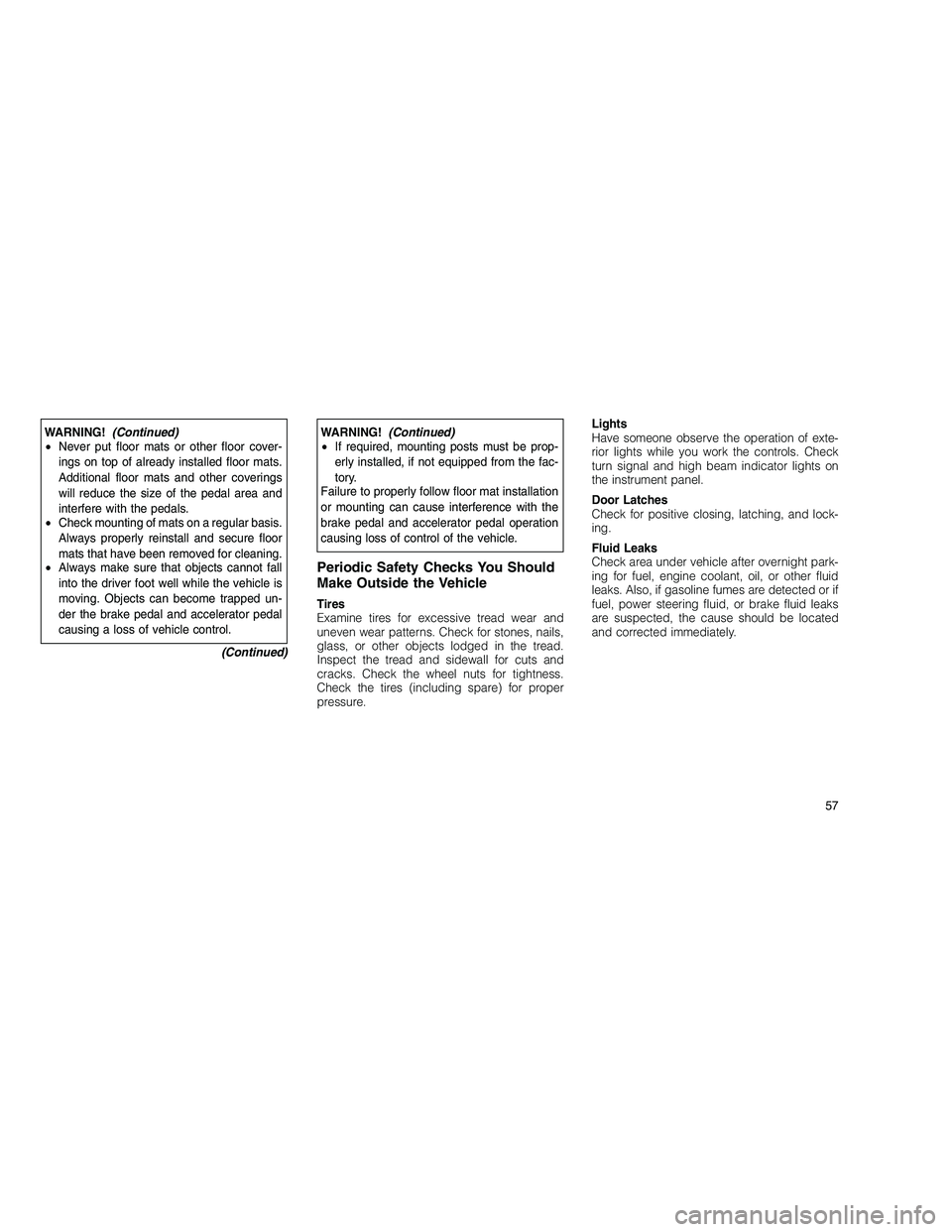
WARNING!(Continued)
• Never put floor mats or other floor cover-
ings on top of already installed floor mats.
Additional floor mats and other coverings
will reduce the size of the pedal area and
interfere with the pedals.
• Check mounting of mats on a regular basis.
Always properly reinstall and secure floor
mats that have been removed for cleaning.
• Always make sure that objects cannot fall
into the driver foot well while the vehicle is
moving. Objects can become trapped un-
der the brake pedal and accelerator pedal
causing a loss of vehicle control.
(Continued)WARNING!(Continued)
• If required, mounting posts must be prop-
erly installed, if not equipped from the fac-
tory.
Failure to properly follow floor mat installation
or mounting can cause interference with the
brake pedal and accelerator pedal operation
causing loss of control of the vehicle.
Periodic Safety Checks You Should
Make Outside the Vehicle
Tires
Examine tires for excessive tread wear and
uneven wear patterns. Check for stones, nails,
glass, or other objects lodged in the tread.
Inspect the tread and sidewall for cuts and
cracks. Check the wheel nuts for tightness.
Check the tires (including spare) for proper
pressure. Lights
Have someone observe the operation of exte-
rior lights while you work the controls. Check
turn signal and high beam indicator lights on
the instrument panel.
Door Latches
Check for positive closing, latching, and lock-
ing.
Fluid Leaks
Check area under vehicle after overnight park-
ing for fuel, engine coolant, oil, or other fluid
leaks. Also, if gasoline fumes are detected or if
fuel, power steering fluid, or brake fluid leaks
are suspected, the cause should be located
and corrected immediately.
57
Page 167 of 350
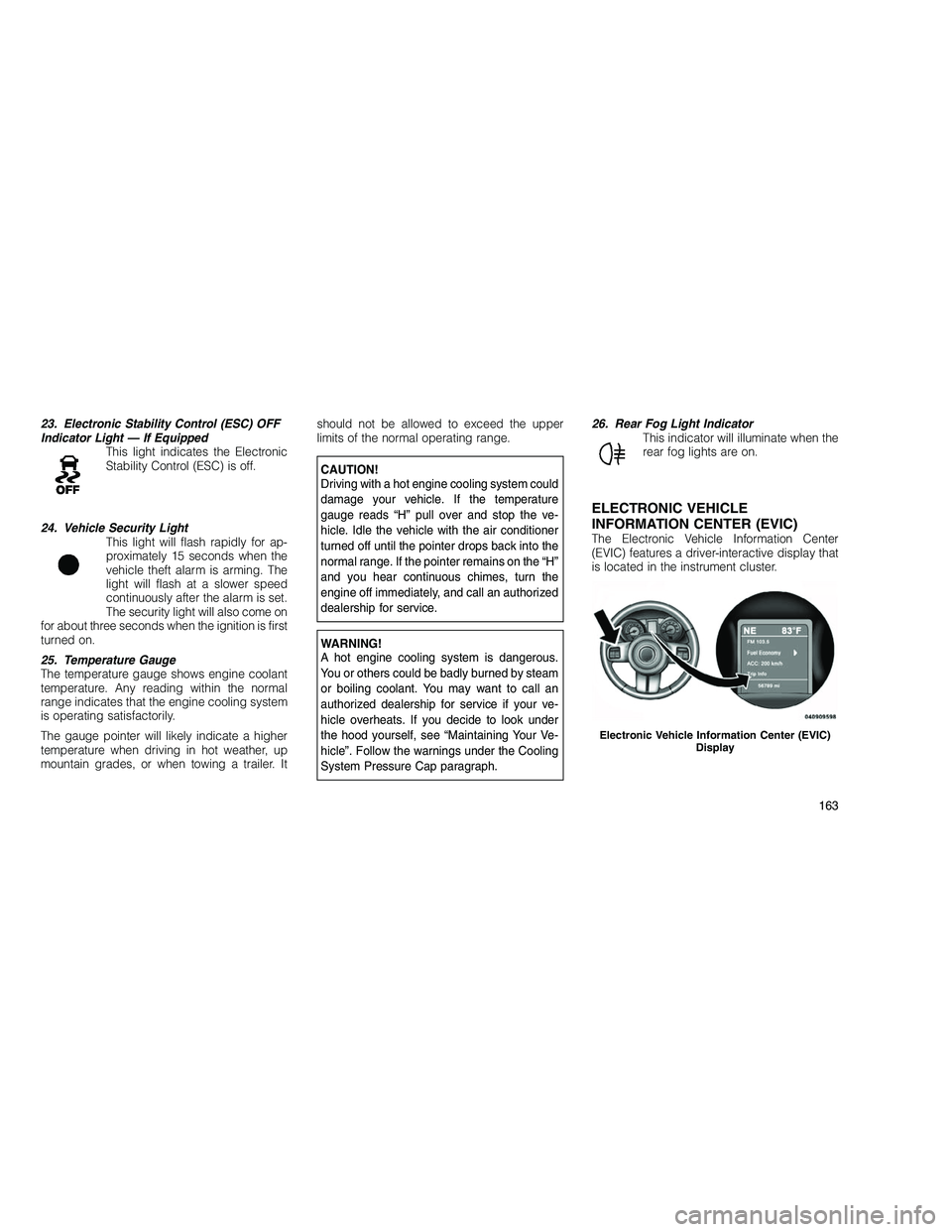
23. Electronic Stability Control (ESC) OFF
Indicator Light — If EquippedThis light indicates the Electronic
Stability Control (ESC) is off.
24. Vehicle Security Light This light will flash rapidly for ap-
proximately 15 seconds when the
vehicle theft alarm is arming. The
light will flash at a slower speed
continuously after the alarm is set.
The security light will also come on
for about three seconds when the ignition is first
turned on.
25. Temperature Gauge
The temperature gauge shows engine coolant
temperature. Any reading within the normal
range indicates that the engine cooling system
is operating satisfactorily.
The gauge pointer will likely indicate a higher
temperature when driving in hot weather, up
mountain grades, or when towing a trailer. It should not be allowed to exceed the upper
limits of the normal operating range.
CAUTION!
Driving with a hot engine cooling system could
damage your vehicle. If the temperature
gauge reads “H” pull over and stop the ve-
hicle. Idle the vehicle with the air conditioner
turned off until the pointer drops back into the
normal range. If the pointer remains on the “H”
and you hear continuous chimes, turn the
engine off immediately, and call an authorized
dealership for service.
WARNING!
A hot engine cooling system is dangerous.
You or others could be badly burned by steam
or boiling coolant. You may want to call an
authorized dealership for service if your ve-
hicle overheats. If you decide to look under
the hood yourself, see “Maintaining Your Ve-
hicle”. Follow the warnings under the Cooling
System Pressure Cap paragraph.26. Rear Fog Light Indicator
This indicator will illuminate when the
rear fog lights are on.
ELECTRONIC VEHICLE
INFORMATION CENTER (EVIC)
The Electronic Vehicle Information Center
(EVIC) features a driver-interactive display that
is located in the instrument cluster.
Electronic Vehicle Information Center (EVIC)
Display
163
Page 177 of 350
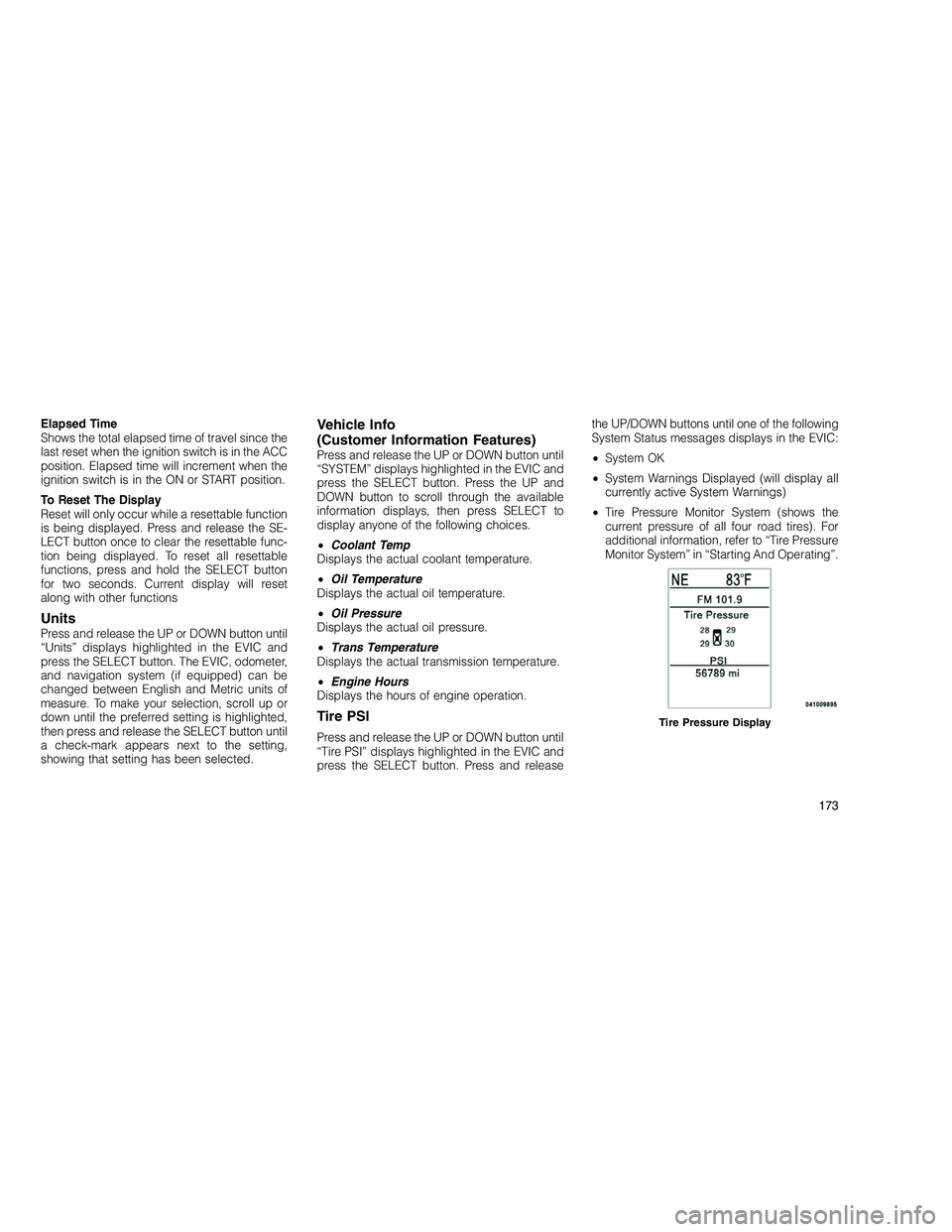
Elapsed Time
Shows the total elapsed time of travel since the
last reset when the ignition switch is in the ACC
position. Elapsed time will increment when the
ignition switch is in the ON or START position.
To Reset The Display
Reset will only occur while a resettable function
is being displayed. Press and release the SE-
LECT button once to clear the resettable func-
tion being displayed. To reset all resettable
functions, press and hold the SELECT button
for two seconds. Current display will reset
along with other functions
UnitsPress and release the UP or DOWN button until
“Units” displays highlighted in the EVIC and
press the SELECT button. The EVIC, odometer,
and navigation system (if equipped) can be
changed between English and Metric units of
measure. To make your selection, scroll up or
down until the preferred setting is highlighted,
then press and release the SELECT button until
a check-mark appears next to the setting,
showing that setting has been selected.
Vehicle Info
(Customer Information Features)
Press and release the UP or DOWN button until
“SYSTEM” displays highlighted in the EVIC and
press the SELECT button. Press the UP and
DOWN button to scroll through the available
information displays, then press SELECT to
display anyone of the following choices.
•Coolant Temp
Displays the actual coolant temperature.
• Oil Temperature
Displays the actual oil temperature.
• Oil Pressure
Displays the actual oil pressure.
• Trans Temperature
Displays the actual transmission temperature.
• Engine Hours
Displays the hours of engine operation.
Tire PSI
Press and release the UP or DOWN button until
“Tire PSI” displays highlighted in the EVIC and
press the SELECT button. Press and release the UP/DOWN buttons until one of the following
System Status messages displays in the EVIC:
•
System OK
• System Warnings Displayed (will display all
currently active System Warnings)
• Tire Pressure Monitor System (shows the
current pressure of all four road tires). For
additional information, refer to “Tire Pressure
Monitor System” in “Starting And Operating”.Tire Pressure Display
173
Page 208 of 350
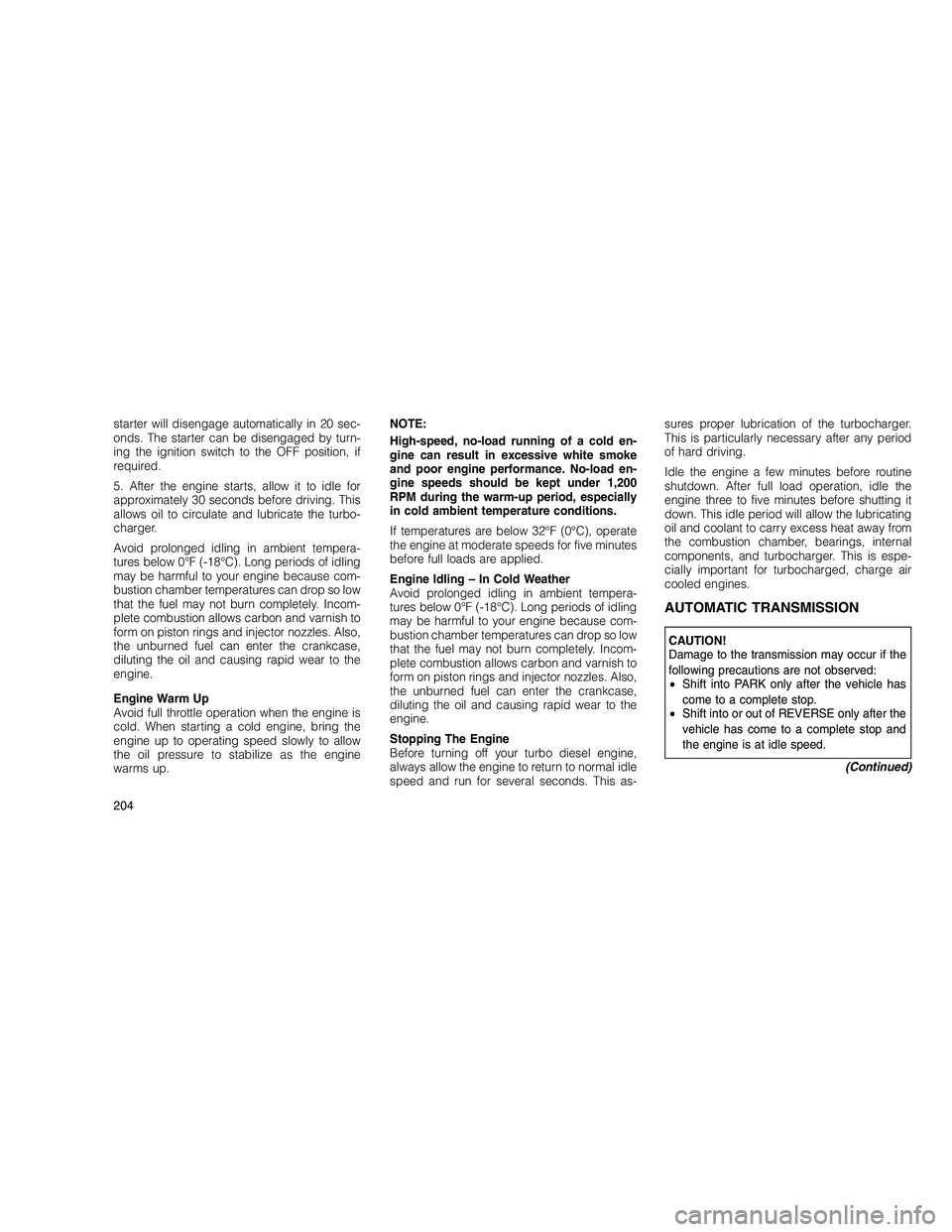
starter will disengage automatically in 20 sec-
onds. The starter can be disengaged by turn-
ing the ignition switch to the OFF position, if
required.
5. After the engine starts, allow it to idle for
approximately 30 seconds before driving. This
allows oil to circulate and lubricate the turbo-
charger.
Avoid prolonged idling in ambient tempera-
tures below 0°F (-18°C). Long periods of idling
may be harmful to your engine because com-
bustion chamber temperatures can drop so low
that the fuel may not burn completely. Incom-
plete combustion allows carbon and varnish to
form on piston rings and injector nozzles. Also,
the unburned fuel can enter the crankcase,
diluting the oil and causing rapid wear to the
engine.
Engine Warm Up
Avoid full throttle operation when the engine is
cold. When starting a cold engine, bring the
engine up to operating speed slowly to allow
the oil pressure to stabilize as the engine
warms up.NOTE:
High-speed, no-load running of a cold en-
gine can result in excessive white smoke
and poor engine performance. No-load en-
gine speeds should be kept under 1,200
RPM during the warm-up period, especially
in cold ambient temperature conditions.
If temperatures are below 32°F (0°C), operate
the engine at moderate speeds for five minutes
before full loads are applied.
Engine Idling – In Cold Weather
Avoid prolonged idling in ambient tempera-
tures below 0°F (-18°C). Long periods of idling
may be harmful to your engine because com-
bustion chamber temperatures can drop so low
that the fuel may not burn completely. Incom-
plete combustion allows carbon and varnish to
form on piston rings and injector nozzles. Also,
the unburned fuel can enter the crankcase,
diluting the oil and causing rapid wear to the
engine.
Stopping The Engine
Before turning off your turbo diesel engine,
always allow the engine to return to normal idle
speed and run for several seconds. This as-sures proper lubrication of the turbocharger.
This is particularly necessary after any period
of hard driving.
Idle the engine a few minutes before routine
shutdown. After full load operation, idle the
engine three to five minutes before shutting it
down. This idle period will allow the lubricating
oil and coolant to carry excess heat away from
the combustion chamber, bearings, internal
components, and turbocharger. This is espe-
cially important for turbocharged, charge air
cooled engines.
AUTOMATIC TRANSMISSION
CAUTION!
Damage to the transmission may occur if the
following precautions are not observed:
•
Shift into PARK only after the vehicle has
come to a complete stop.
• Shift into or out of REVERSE only after the
vehicle has come to a complete stop and
the engine is at idle speed.
(Continued)
204
Page 212 of 350
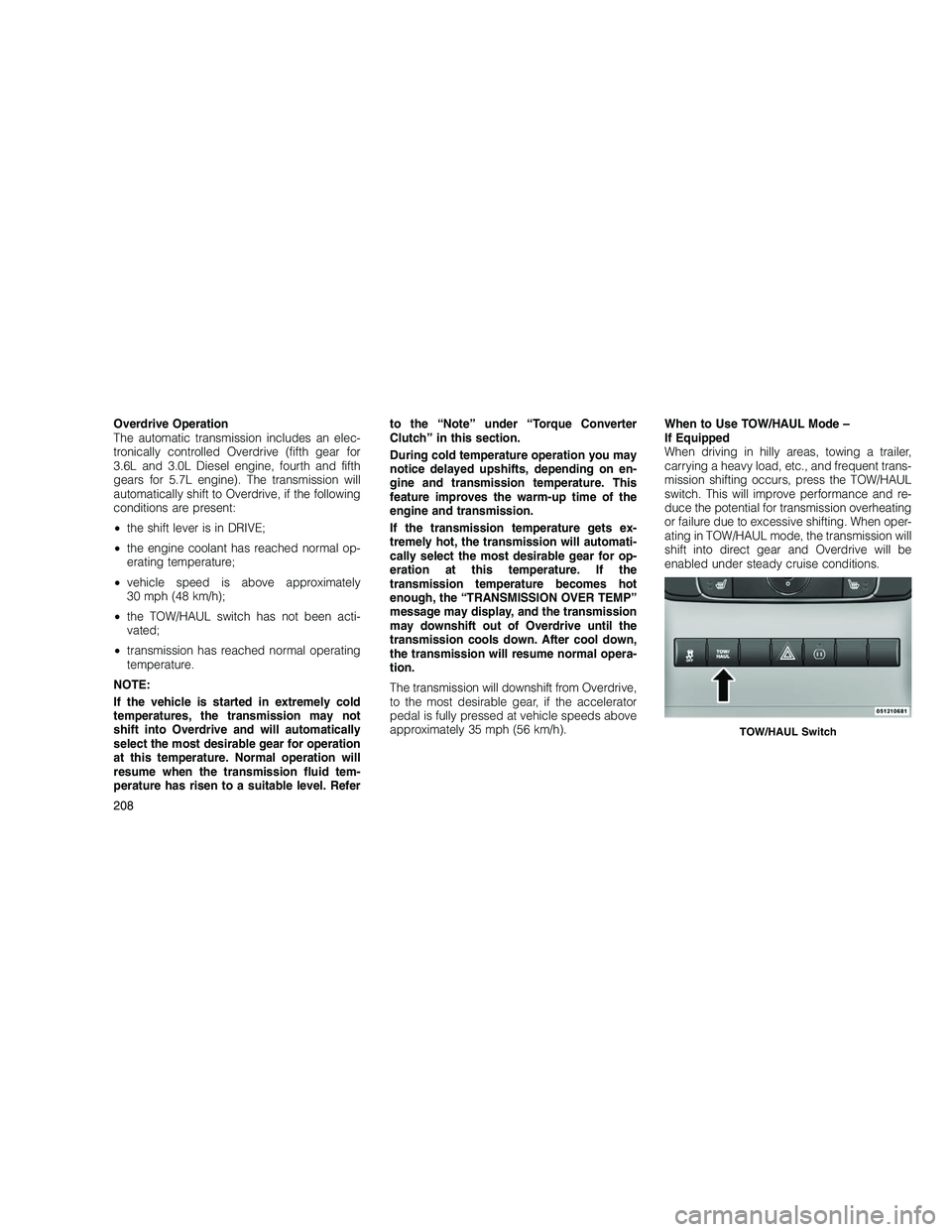
Overdrive Operation
The automatic transmission includes an elec-
tronically controlled Overdrive (fifth gear for
3.6L and 3.0L Diesel engine, fourth and fifth
gears for 5.7L engine). The transmission will
automatically shift to Overdrive, if the following
conditions are present:
•the shift lever is in DRIVE;
• the engine coolant has reached normal op-
erating temperature;
• vehicle speed is above approximately
30 mph (48 km/h);
• the TOW/HAUL switch has not been acti-
vated;
• transmission has reached normal operating
temperature.
NOTE:
If the vehicle is started in extremely cold
temperatures, the transmission may not
shift into Overdrive and will automatically
select the most desirable gear for operation
at this temperature. Normal operation will
resume when the transmission fluid tem-
perature has risen to a suitable level. Refer to the “Note” under “Torque Converter
Clutch” in this section.
During cold temperature operation you may
notice delayed upshifts, depending on en-
gine and transmission temperature. This
feature improves the warm-up time of the
engine and transmission.
If the transmission temperature gets ex-
tremely hot, the transmission will automati-
cally select the most desirable gear for op-
eration at this temperature. If the
transmission temperature becomes hot
enough, the “TRANSMISSION OVER TEMP”
message may display, and the transmission
may downshift out of Overdrive until the
transmission cools down. After cool down,
the transmission will resume normal opera-
tion.
The transmission will downshift from Overdrive,
to the most desirable gear, if the accelerator
pedal is fully pressed at vehicle speeds above
approximately 35 mph (56 km/h).
When to Use TOW/HAUL Mode –
If Equipped
When driving in hilly areas, towing a trailer,
carrying a heavy load, etc., and frequent trans-
mission shifting occurs, press the TOW/HAUL
switch. This will improve performance and re-
duce the potential for transmission overheating
or failure due to excessive shifting. When oper-
ating in TOW/HAUL mode, the transmission will
shift into direct gear and Overdrive will be
enabled under steady cruise conditions.
TOW/HAUL Switch
208
Page 213 of 350
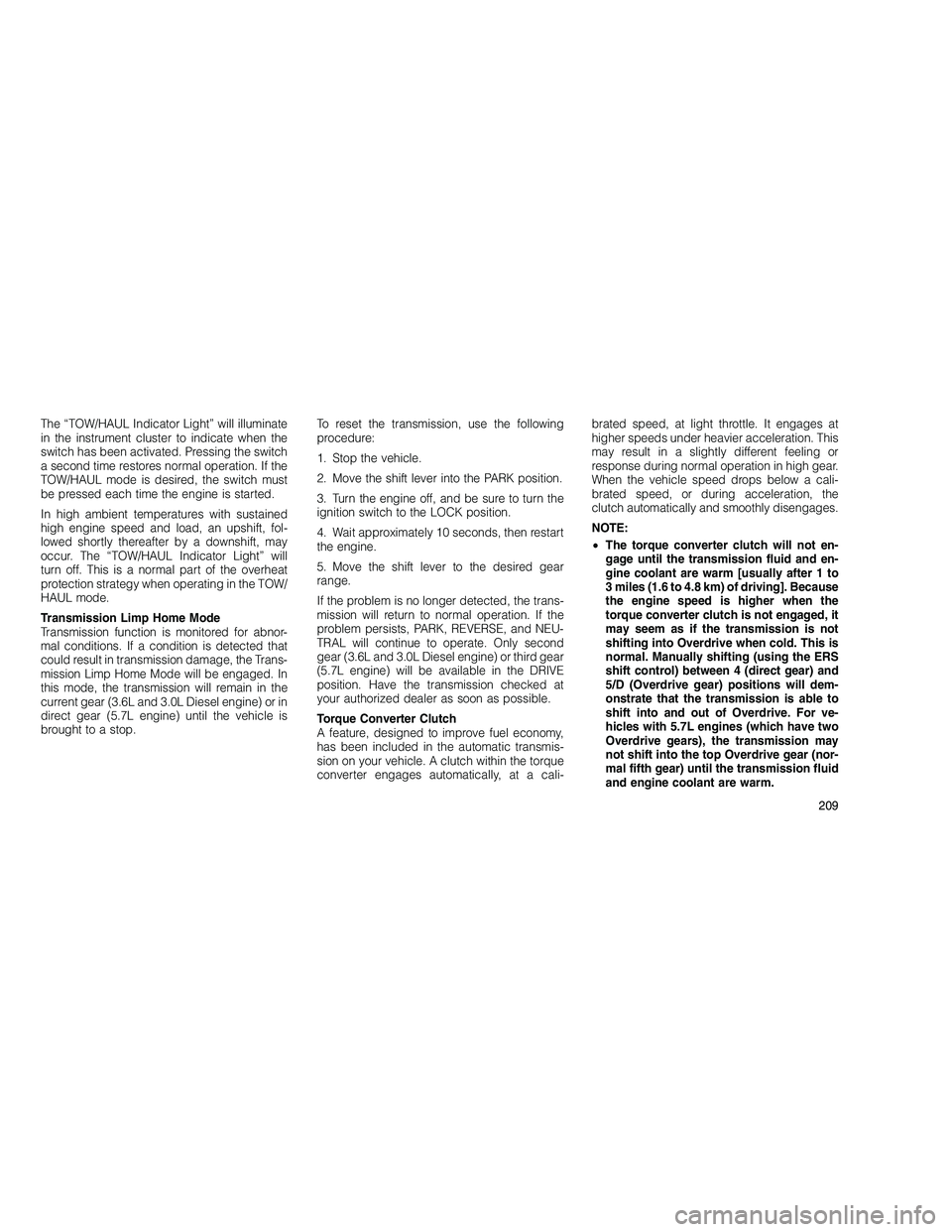
The “TOW/HAUL Indicator Light” will illuminate
in the instrument cluster to indicate when the
switch has been activated. Pressing the switch
a second time restores normal operation. If the
TOW/HAUL mode is desired, the switch must
be pressed each time the engine is started.
In high ambient temperatures with sustained
high engine speed and load, an upshift, fol-
lowed shortly thereafter by a downshift, may
occur. The “TOW/HAUL Indicator Light” will
turn off. This is a normal part of the overheat
protection strategy when operating in the TOW/
HAUL mode.
Transmission Limp Home Mode
Transmission function is monitored for abnor-
mal conditions. If a condition is detected that
could result in transmission damage, the Trans-
mission Limp Home Mode will be engaged. In
this mode, the transmission will remain in the
current gear (3.6L and 3.0L Diesel engine) or in
direct gear (5.7L engine) until the vehicle is
brought to a stop.To reset the transmission, use the following
procedure:
1. Stop the vehicle.
2. Move the shift lever into the PARK position.
3. Turn the engine off, and be sure to turn the
ignition switch to the LOCK position.
4. Wait approximately 10 seconds, then restart
the engine.
5. Move the shift lever to the desired gear
range.
If the problem is no longer detected, the trans-
mission will return to normal operation. If the
problem persists, PARK, REVERSE, and NEU-
TRAL will continue to operate. Only second
gear (3.6L and 3.0L Diesel engine) or third gear
(5.7L engine) will be available in the DRIVE
position. Have the transmission checked at
your authorized dealer as soon as possible.
Torque Converter Clutch
A feature, designed to improve fuel economy,
has been included in the automatic transmis-
sion on your vehicle. A clutch within the torque
converter engages automatically, at a cali-brated speed, at light throttle. It engages at
higher speeds under heavier acceleration. This
may result in a slightly different feeling or
response during normal operation in high gear.
When the vehicle speed drops below a cali-
brated speed, or during acceleration, the
clutch automatically and smoothly disengages.
NOTE:
•
The torque converter clutch will not en-
gage until the transmission fluid and en-
gine coolant are warm [usually after 1 to
3 miles (1.6 to 4.8 km) of driving]. Because
the engine speed is higher when the
torque converter clutch is not engaged, it
may seem as if the transmission is not
shifting into Overdrive when cold. This is
normal. Manually shifting (using the ERS
shift control) between 4 (direct gear) and
5/D (Overdrive gear) positions will dem-
onstrate that the transmission is able to
shift into and out of Overdrive. For ve-
hicles with 5.7L engines (which have two
Overdrive gears), the transmission may
not shift into the top Overdrive gear (nor-
mal fifth gear) until the transmission fluid
and engine coolant are warm.
209
Page 262 of 350
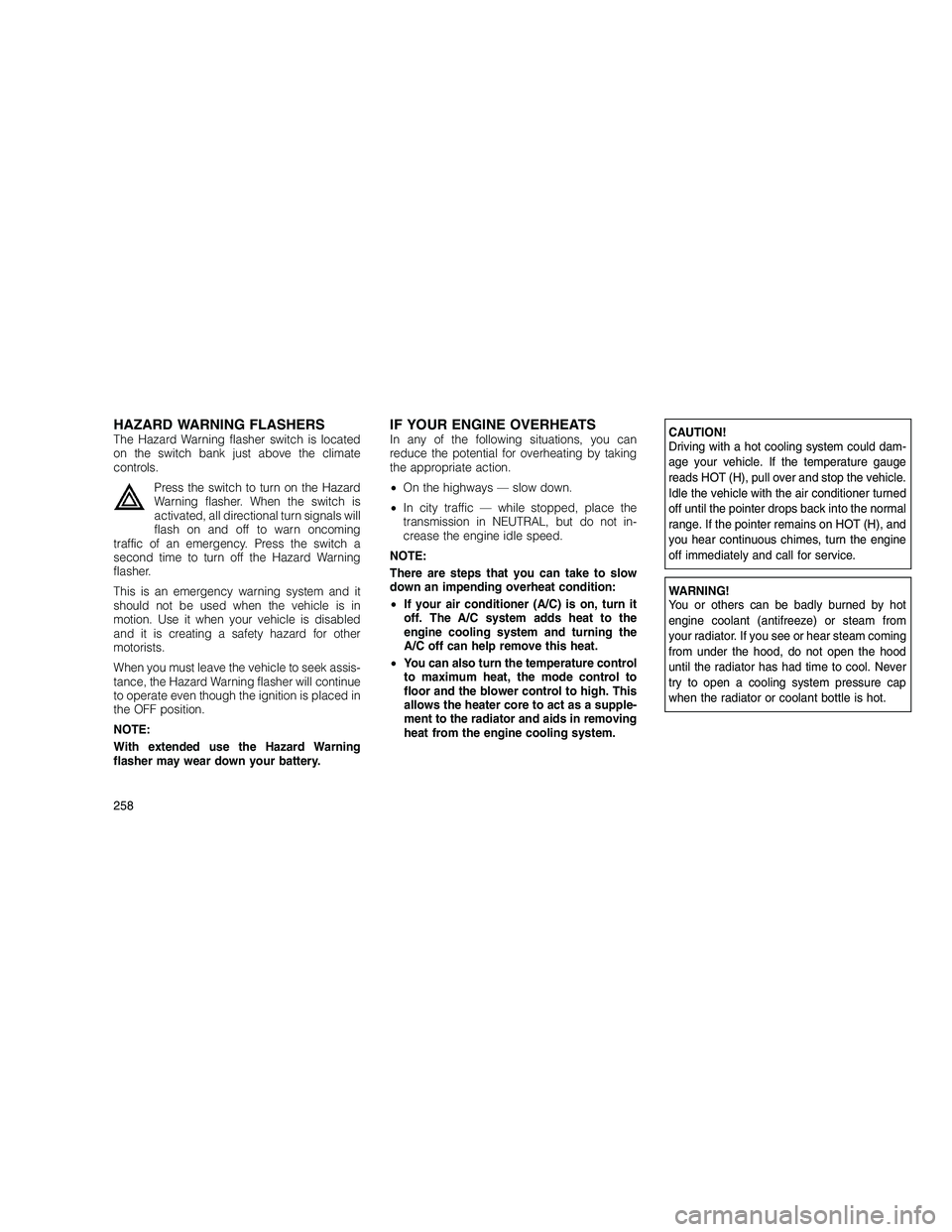
HAZARD WARNING FLASHERSThe Hazard Warning flasher switch is located
on the switch bank just above the climate
controls.Press the switch to turn on the Hazard
Warning flasher. When the switch is
activated, all directional turn signals will
flash on and off to warn oncoming
traffic of an emergency. Press the switch a
second time to turn off the Hazard Warning
flasher.
This is an emergency warning system and it
should not be used when the vehicle is in
motion. Use it when your vehicle is disabled
and it is creating a safety hazard for other
motorists.
When you must leave the vehicle to seek assis-
tance, the Hazard Warning flasher will continue
to operate even though the ignition is placed in
the OFF position.
NOTE:
With extended use the Hazard Warning
flasher may wear down your battery.IF YOUR ENGINE OVERHEATSIn any of the following situations, you can
reduce the potential for overheating by taking
the appropriate action.
• On the highways — slow down.
• In city traffic — while stopped, place the
transmission in NEUTRAL, but do not in-
crease the engine idle speed.
NOTE:
There are steps that you can take to slow
down an impending overheat condition:
• If your air conditioner (A/C) is on, turn it
off. The A/C system adds heat to the
engine cooling system and turning the
A/C off can help remove this heat.
• You can also turn the temperature control
to maximum heat, the mode control to
floor and the blower control to high. This
allows the heater core to act as a supple-
ment to the radiator and aids in removing
heat from the engine cooling system.CAUTION!
Driving with a hot cooling system could dam-
age your vehicle. If the temperature gauge
reads HOT (H), pull over and stop the vehicle.
Idle the vehicle with the air conditioner turned
off until the pointer drops back into the normal
range. If the pointer remains on HOT (H), and
you hear continuous chimes, turn the engine
off immediately and call for service.
WARNING!
You or others can be badly burned by hot
engine coolant (antifreeze) or steam from
your radiator. If you see or hear steam coming
from under the hood, do not open the hood
until the radiator has had time to cool. Never
try to open a cooling system pressure cap
when the radiator or coolant bottle is hot.
258
Page 274 of 350
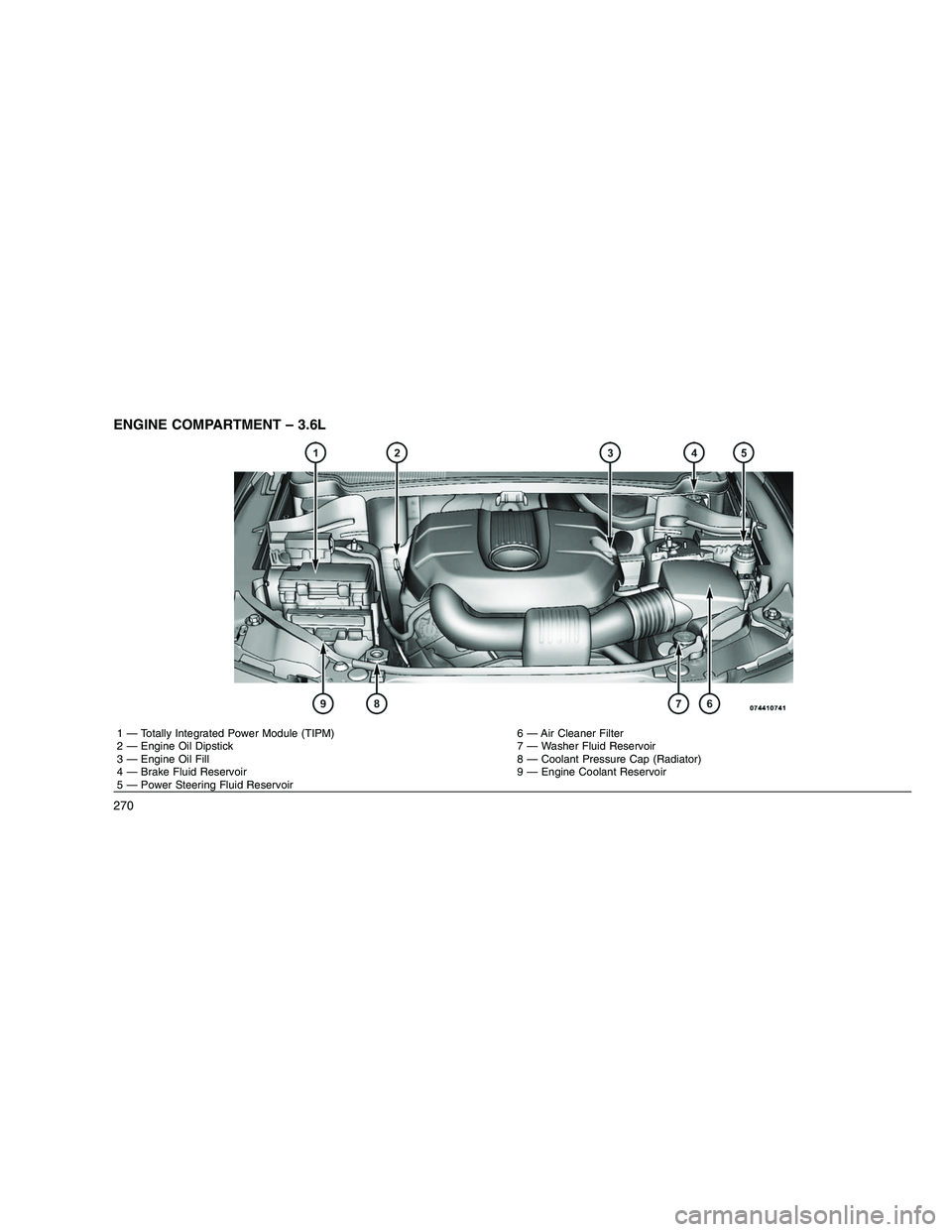
ENGINE COMPARTMENT – 3.6L
1 — Totally Integrated Power Module (TIPM) 6 — Air Cleaner Filter
2 — Engine Oil Dipstick 7 — Washer Fluid Reservoir
3 — Engine Oil Fill 8 — Coolant Pressure Cap (Radiator)
4 — Brake Fluid Reservoir 9 — Engine Coolant Reservoir
5 — Power Steering Fluid Reservoir
270
Page 275 of 350
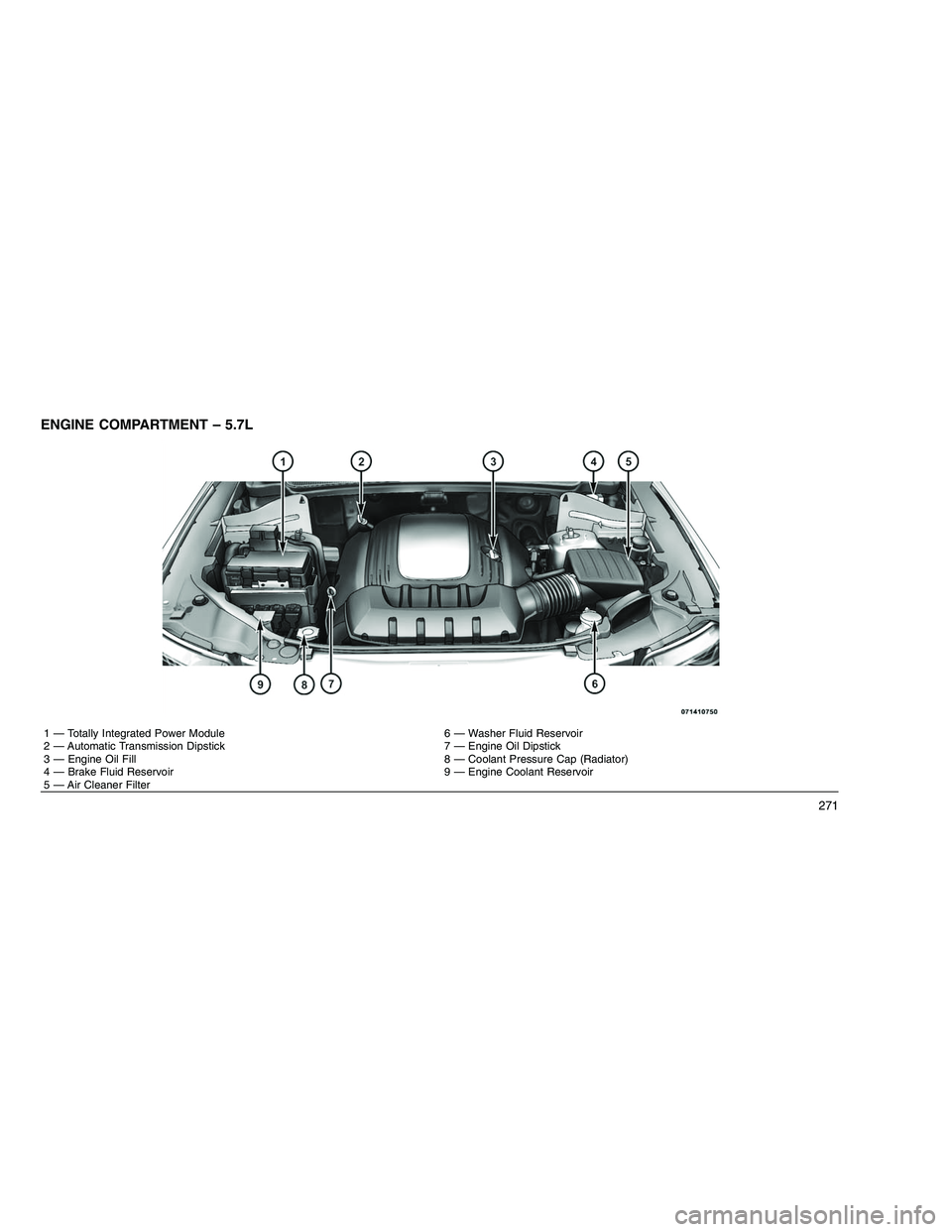
ENGINE COMPARTMENT – 5.7L
1 — Totally Integrated Power Module 6 — Washer Fluid Reservoir
2 — Automatic Transmission Dipstick 7 — Engine Oil Dipstick
3 — Engine Oil Fill 8 — Coolant Pressure Cap (Radiator)
4 — Brake Fluid Reservoir 9 — Engine Coolant Reservoir
5 — Air Cleaner Filter
271
Page 276 of 350
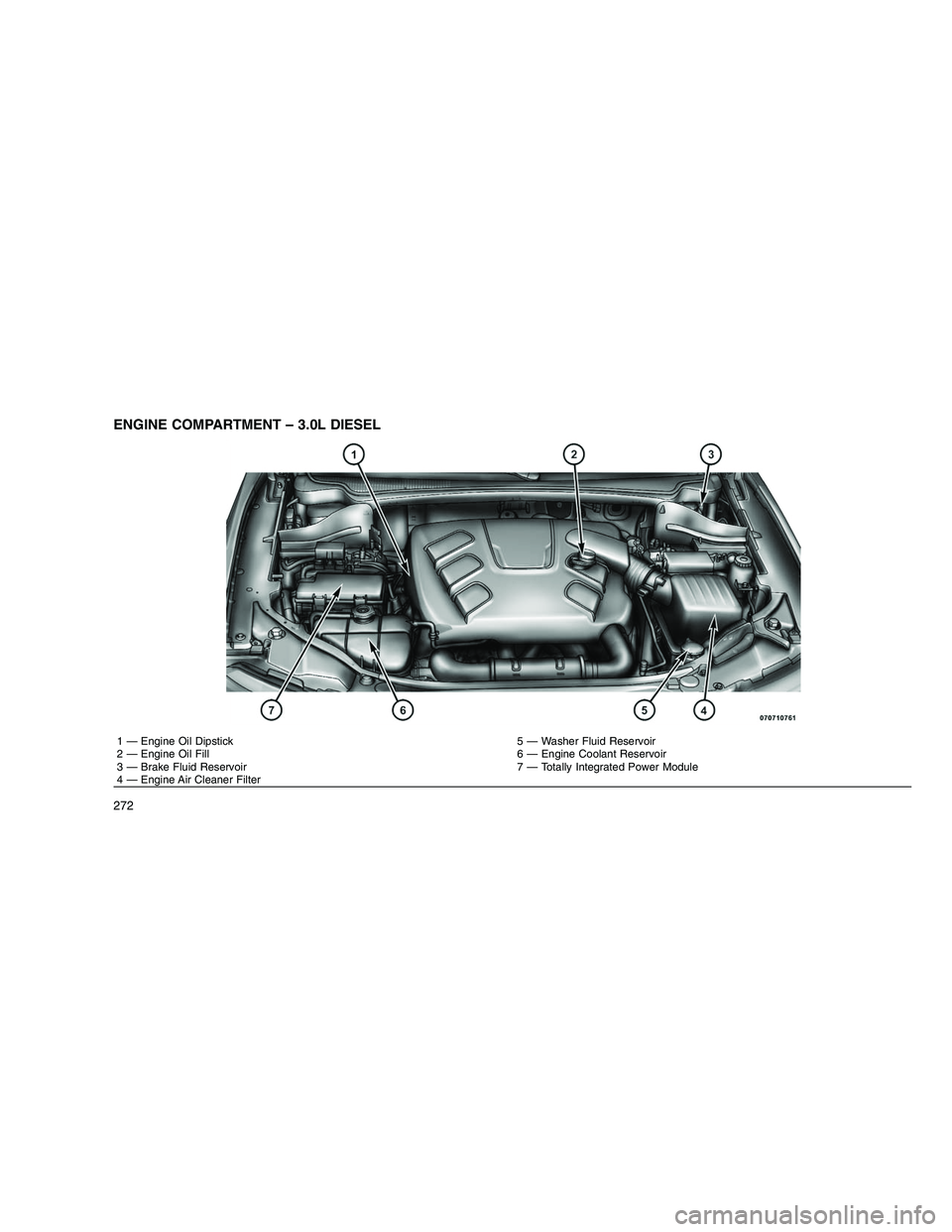
ENGINE COMPARTMENT – 3.0L DIESEL
1 — Engine Oil Dipstick 5 — Washer Fluid Reservoir
2 — Engine Oil Fill 6 — Engine Coolant Reservoir
3 — Brake Fluid Reservoir 7 — Totally Integrated Power Module
4 — Engine Air Cleaner Filter
272